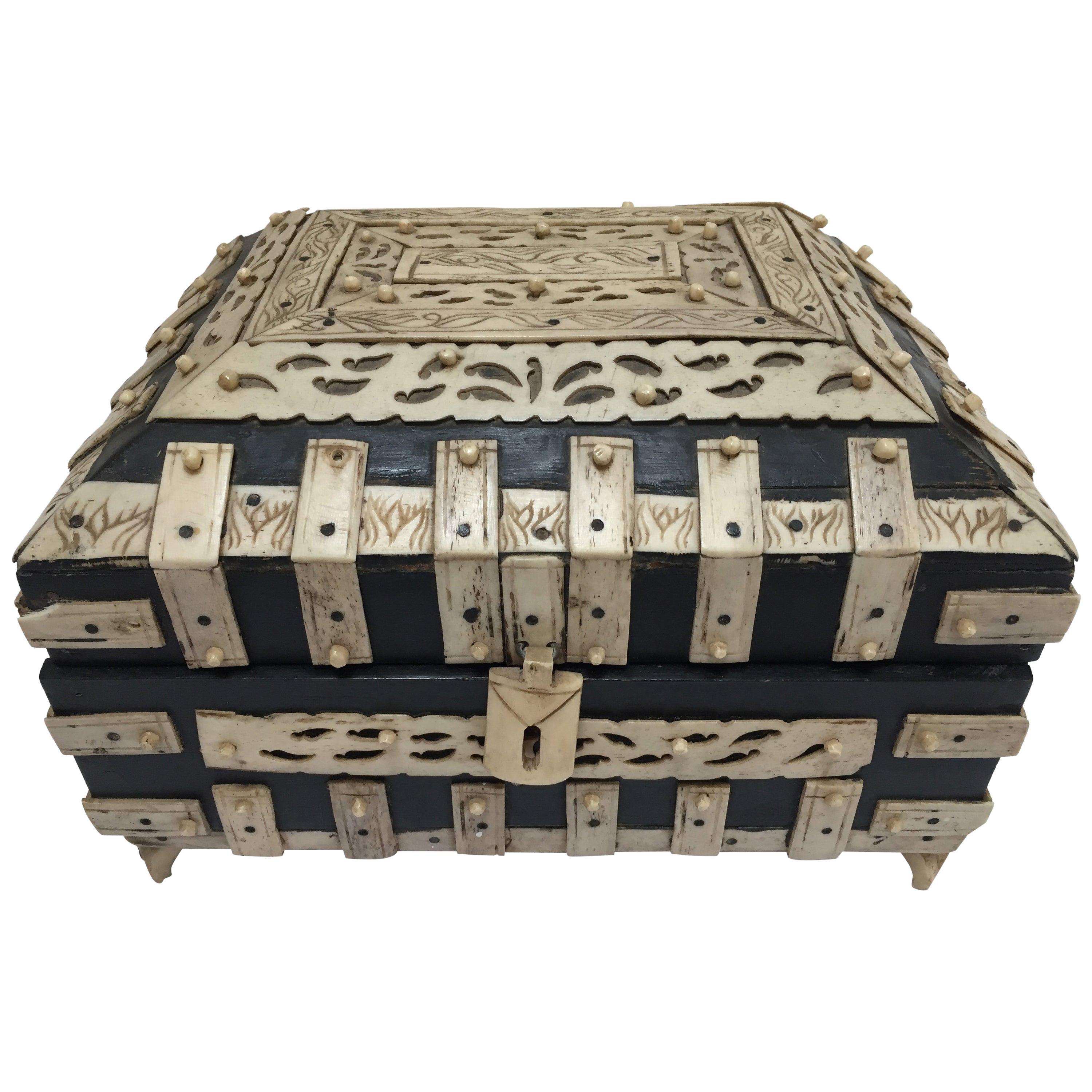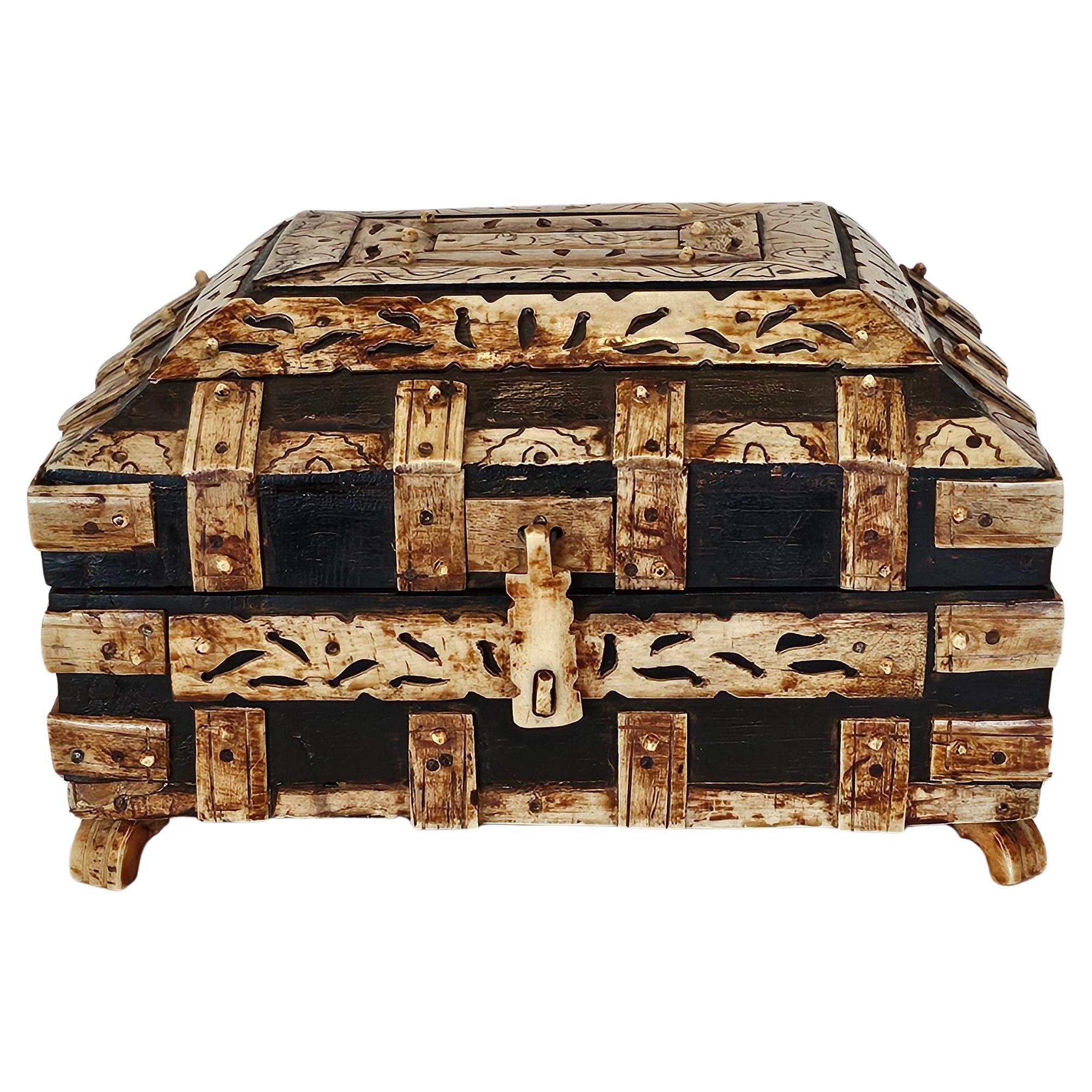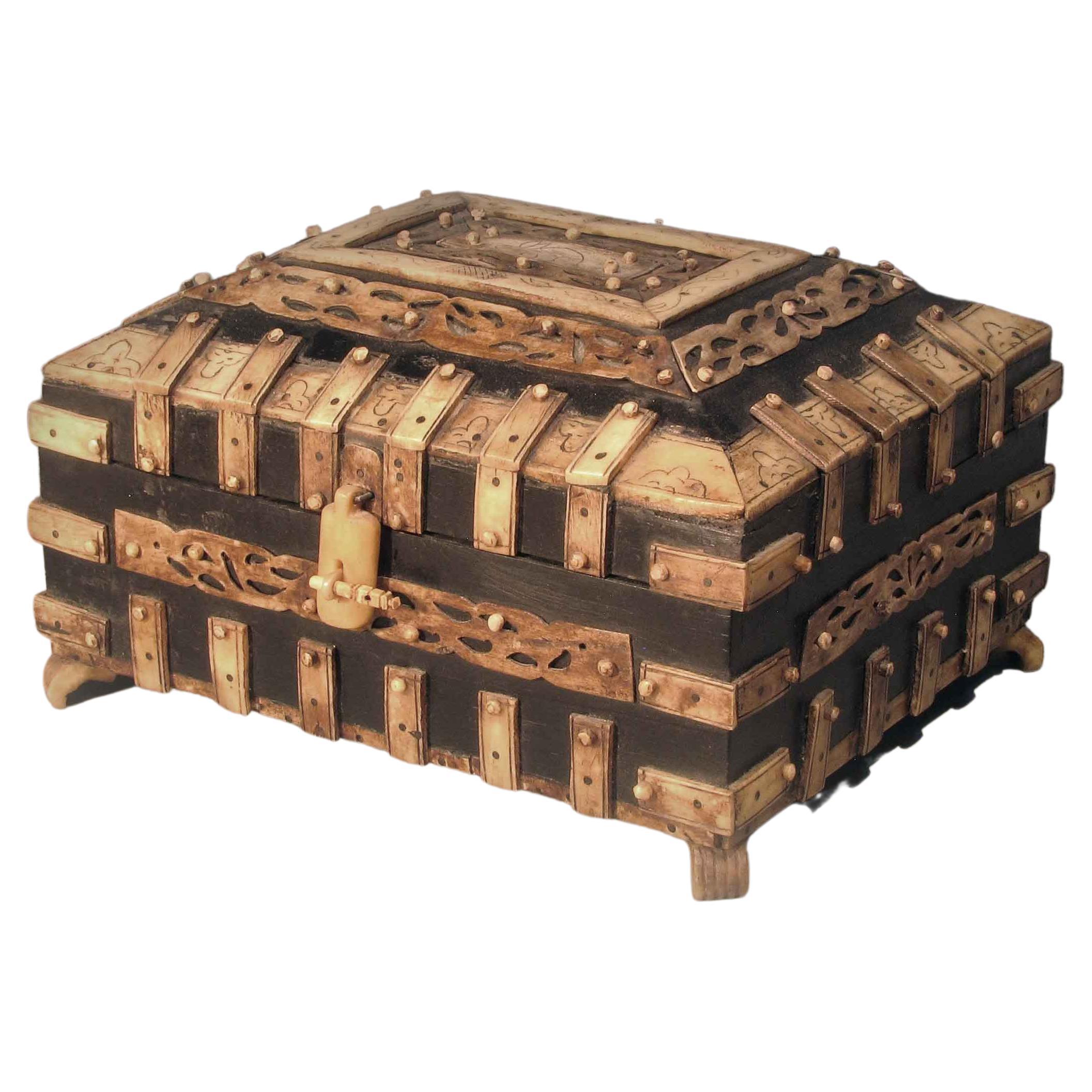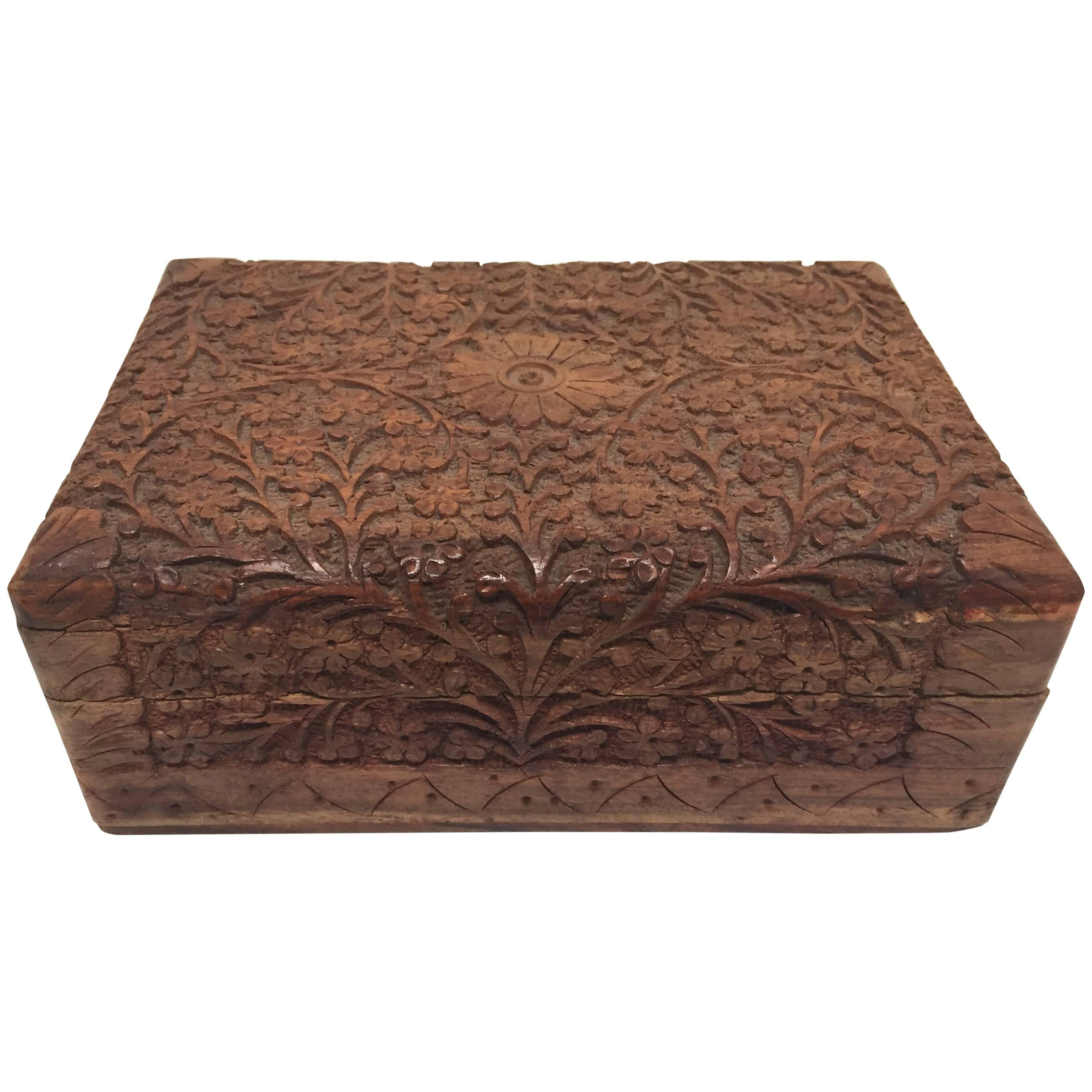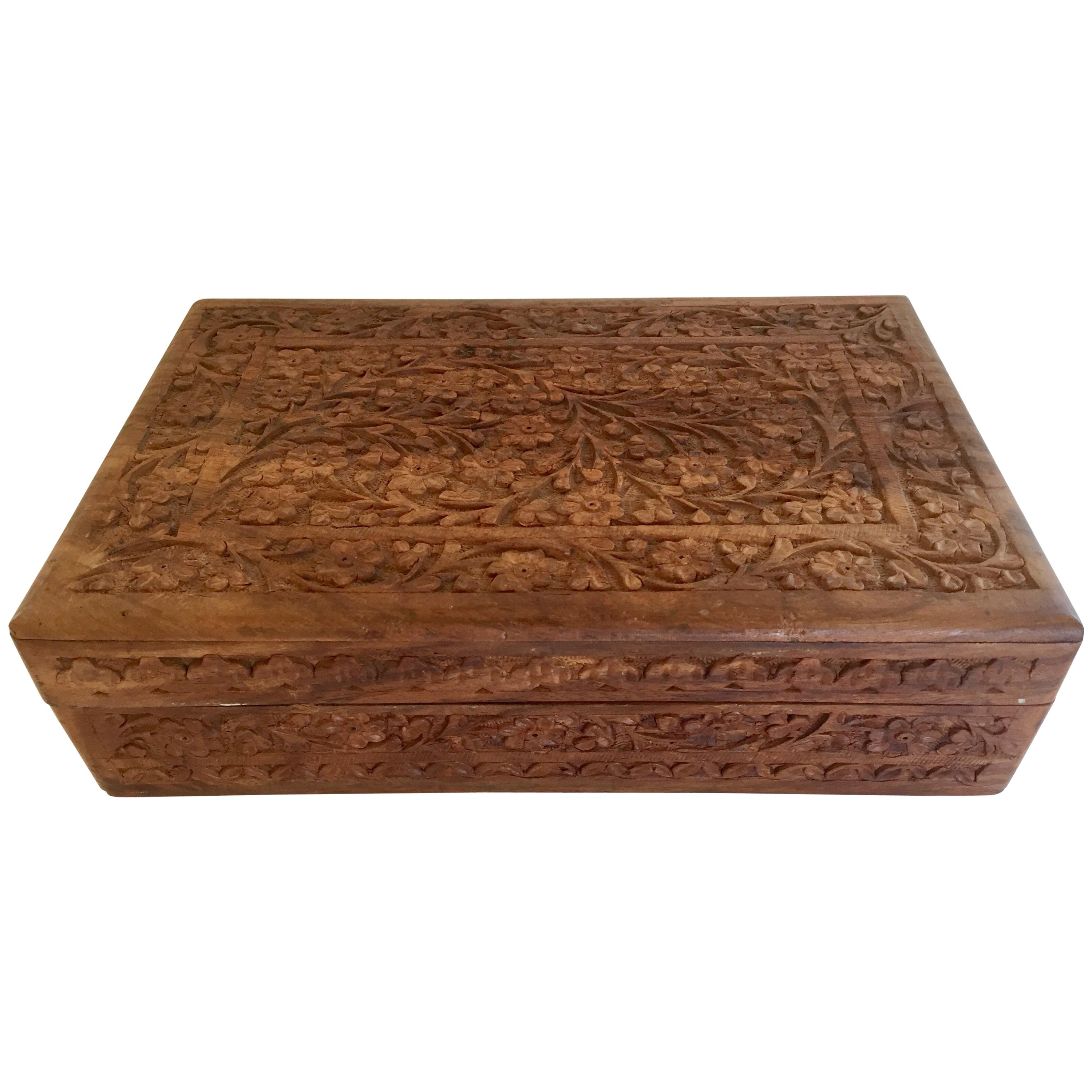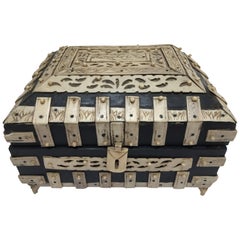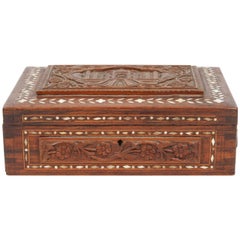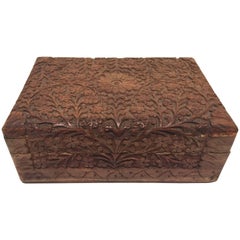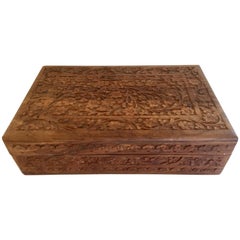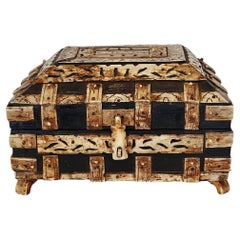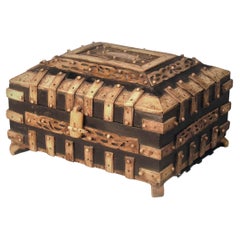Items Similar to Antique 19th c. Decorative Anglo-Indian Overlay Footed Box with Engraved Bone
Want more images or videos?
Request additional images or videos from the seller
1 of 21
Antique 19th c. Decorative Anglo-Indian Overlay Footed Box with Engraved Bone
$1,650
£1,227.32
€1,436.95
CA$2,302.31
A$2,576.35
CHF 1,345.25
MX$31,673.54
NOK 16,971.87
SEK 15,970.44
DKK 10,720.75
Shipping
Retrieving quote...The 1stDibs Promise:
Authenticity Guarantee,
Money-Back Guarantee,
24-Hour Cancellation
About the Item
Nice and unusual Jewelry decorative box with filigree bone overlaid decoration.
Large Anglo-Indian footed domed box with exceptional engraved bone details throughout with filigree with arabesque carving.
Vizagapatam, late 19th century.
Dimensions: Height: 6.5 in (16.51 cm)Width: 9.75 in (24.77 cm)Depth: 8 in (20.32 cm)
Anglo-Indian footed domed box with exceptional engraved details throughout with filigree and carved veneered plaques with arabesque carving. Vizagapatam, late 19th century. History of the Anglo-Indian Boxes Beginning in the early part of the 18th century, Indian artisans made what came to be known as Anglo-Indian boxes for the English residents living in India, who eventually brought or sent them back to England. At the beginning of the 19th century, India began exporting these boxes commercially, although not in any significant numbers until the 1850s. People valued them so highly that manufacturers of tins copied the designs on them in the late 19th and early 20th century. Anglo-Indian boxes fall into four groups: Rosewood or ebony boxes inlaid; sandalwood boxes veneered; sandalwood boxes covered with Sadeli mosaic; and carved boxes often combined with Sadeli mosaic/ The first two categories came from Vizagapatam in East India while the last two came from Bombay in West India. English traders discovered the rich woods and intricate workmanship of Indian artisans, so colonial government officials began to recognize the work of the Indian artists and craftsmen as a source for satisfying the need for furniture and boxes, which would both serve to enhance English households in India. This gave rise to the cabinetmaking workshops in Vizagapatam between Calcutta and Madras. Craftsmen made the first boxes to be decorated with Sadeli mosaic of rosewood or ebony, incised to give further definition to the decoration, directly inlaid into the wood. The shape of the early boxes was either sloping at the front with a flatter section at the back, reminiscent of English writing slopes, or rectangular. Artisans inlaid the borders with stylized floral scrolls and the centers with a single floral motif following a circular or oval symmetrical or asymmetrical pattern. The edging was ornamental and protective, both helped protect the end grain against the weather. Made in Vizagapatam, situated on the south east coast of India, near Madras These exotic boxes were crafted and retailed in Madras and Calcutta by the English and Dutch East India Companies. Made in Vizagapatam, situated on the south east coast of India, near Madras
- Creator:Rajhastani (Artist)
- Dimensions:Height: 6.5 in (16.51 cm)Width: 9.75 in (24.77 cm)Depth: 8 in (20.32 cm)
- Style:Anglo Raj (In the Style Of)
- Materials and Techniques:
- Place of Origin:
- Period:
- Date of Manufacture:1880
- Condition:Wear consistent with age and use. Minor losses. Minor fading. Good. Wear consistent with age and use. Minor losses. Minor fading.
- Seller Location:North Hollywood, CA
- Reference Number:Seller: AG7201stDibs: LU906824928682
About the Seller
5.0
Platinum Seller
Premium sellers with a 4.7+ rating and 24-hour response times
1stDibs seller since 2011
3,037 sales on 1stDibs
Typical response time: 1 hour
- ShippingRetrieving quote...Shipping from: North Hollywood, CA
- Return Policy
Authenticity Guarantee
In the unlikely event there’s an issue with an item’s authenticity, contact us within 1 year for a full refund. DetailsMoney-Back Guarantee
If your item is not as described, is damaged in transit, or does not arrive, contact us within 7 days for a full refund. Details24-Hour Cancellation
You have a 24-hour grace period in which to reconsider your purchase, with no questions asked.Vetted Professional Sellers
Our world-class sellers must adhere to strict standards for service and quality, maintaining the integrity of our listings.Price-Match Guarantee
If you find that a seller listed the same item for a lower price elsewhere, we’ll match it.Trusted Global Delivery
Our best-in-class carrier network provides specialized shipping options worldwide, including custom delivery.More From This Seller
View AllAnglo-Indian Vizagapatam Bombay Mughal Style Footed Box With Bone Overlay
Located in North Hollywood, CA
Nice and unusual Indian Mughal style large decorative box, filigree and carved horn.
Anglo-Indian footed domed box with exceptional engraved details throughout with filigree and carved veneered bone plaques with arabesque carving.
Vizagapatam, late 19th century.
History of the Anglo-Indian Boxes
Beginning in the early part of the 18th century, Indian artisans made what came to be known as Anglo-Indian boxes for the English residents living in India, who eventually brought or sent them back to England. At the beginning of the 19th century, India began exporting these boxes commercially, although not in any significant numbers until the 1850s. People valued them so highly that manufacturers of tins copied the designs on them in the late 19th and early 20th century.
Anglo-Indian boxes fall into four groups: Rosewood or ebony boxes inlaid;
sandalwood boxes veneered; sandalwood boxes covered with Sadeli mosaic; and carved boxes often combined with Sadeli mosaic/
The first two categories came from Vizagapatam in East India while the last two came from Bombay in West India.
English traders discovered the rich woods and intricate workmanship of Indian artisans, so colonial government officials began to recognize the work of the Indian artists and craftsmen as a source for satisfying the need for furniture and boxes, which would both serve to enhance English households in India. This gave rise to the cabinetmaking workshops in Vizagapatam between Calcutta and Madras.
Craftsmen made the first boxes to be decorated with Sadeli mosaic of rosewood or ebony, incised to give further definition to the decoration, directly inlaid into the wood. The shape of the early boxes was either sloping at the front with a flatter section at the back, reminiscent of English writing slopes, or rectangular. Artisans inlaid the borders with stylized floral scrolls and the centers with a single floral motif following a circular or oval symmetrical or asymmetrical pattern. The edging was ornamental and protective, both helped protect the end grain against the weather.
Made in Vizagapatam, situated on the south east coast of India, near Madras
These exotic boxes...
Category
Antique Late 19th Century Indian Anglo Raj Decorative Boxes
Materials
Wood
19th Century Anglo-Indian Mughal Box
Located in North Hollywood, CA
19th century Anglo-Indian Mughal wood box, inlaid and hand carved with the Taj Mahal and some flowers all around.
Jewelry box, Anglo-Raj box from India in great condition.
Nice Mughal Bombay Box...
Category
Antique Late 19th Century Indian Anglo Raj Decorative Boxes
Materials
Sandalwood
Anglo Raj Hand-Carved Decorative Jewelry Box
By Rajhastani
Located in North Hollywood, CA
Hand-carved Anglo Raj early 20th century carved wood box richly decorated overall with arabesques and floral carving.
Hinged lid shallow relief carving with interior lined with red r...
Category
Early 20th Century Indian Anglo Raj Decorative Boxes
Materials
Sandalwood
Anglo Raj Hand-Carved Wooden Decorative Jewelry Box
By Rajhastani
Located in North Hollywood, CA
Hand-carved large wooden Anglo-Raj jewelry box.
Early 20th century wood box richly decorated overall with arabesques and floral carving.
Hinged lid shallow relief carving with interi...
Category
Early 20th Century Indian Anglo Raj Decorative Boxes
Materials
Sandalwood
Fine Antique Anglo Indian Mughal Carved Box
By Rajhastani
Located in North Hollywood, CA
Fine antique Anglo-Indian hand carved wooden jewelry box inlaid.
A Nice Mughal Anglo Indian Pen Box
19th Century
The box with a Mughal I...
Category
Antique Late 19th Century Indian Agra Decorative Boxes
Materials
Wood
Antique Rajasthani Footed Chest Box India 1900's
Located in North Hollywood, CA
Antique Rajasthani Shekhawati Merchant's Footed Chest Box India 1900's.
Early 20th Century Indian carved wood storage cash footed box used by merchants in ...
Category
Early 20th Century Indian Folk Art Decorative Boxes
Materials
Metal
You May Also Like
Antique Vizagapatam India Table Box Ebonized Wood & Bone Carvings
Located in Forney, TX
Vizagapatam box, India, 19th century.
This highly decorative and unusual Anglo-Indian table box features rustic workmanship that adds to the character and charm of this unique Sout...
Category
Antique 19th Century Indian Anglo Raj Decorative Boxes
Materials
Bone, Wood
Very Decorative Vizagapatam Box INDIA 19th Century
Located in Ottawa, Ontario
VERY DECORATIVE VIZAGAPATAM BOX
Vizagapatam, India, 19th Century.
Rustic workmanship will only add to the decorative appeal of this Anglo-Indian footed domed casket in ebonized woo...
Category
Antique 19th Century Indian Anglo-Indian Decorative Boxes
Materials
Bone
Double Height Carved Indian Box
Located in Godshill, Isle of Wight
Double height carved Indian box
An unusual piece with 2 levels, the top of the box in the octagonal shape has an opening lid. The lower is recta...
Category
Early 20th Century Anglo Raj Jewelry Boxes
Materials
Teak
Anglo-Indian 19th century black patinated, Bone and Oak box
Located in West Palm Beach, FL
A very wonderful and most attractive Anglo-Indian 19th century black patinated, Bone and Oak box. This unique rectangular box made of veneered blocks of Bone is supported on four squ...
Category
Antique 19th Century North American Decorative Boxes
Materials
Bone
Antique Anglo Indian Bone and Tortoise Box
Located in Palm Beach, FL
Lofty antique British colonial lidded box handcrafted in indigenous hardwood clad in tortoise shell and decorated with intricate bone designs, featuring an etched and painted center ...
Category
Early 20th Century Indian Anglo-Indian Decorative Boxes
Materials
Tortoise Shell
A Gujarati Timber and Pressed Tin Dowry Box, Early 20th Century
Located in ARMADALE, VIC
A Gujarati Timber and Pressed Tin Dowry Box, Early 20th Century
Provenance:
Private Australia Collection.
Description:
The modestly sized timber dowry box with rivete...
Category
Early 20th Century Indian Decorative Boxes
Materials
Tin
More Ways To Browse
Unusual Jewelry
Filigree Box
Oval Antique Jewelry Box
Box Wood Carving
Anglo Indian Jewelry
Antique South Indian Furniture
India Filigree
Carved Bone Jewelry
Colonial Wood Carvings
Ebony Wood Carving
Antique Bone Carvings
Indian Rosewood Carved
Anglo Indian Ebony
Madras India
Anglo Dutch
Mosaic Plaque
Colonial Ebony
India Sandalwood
